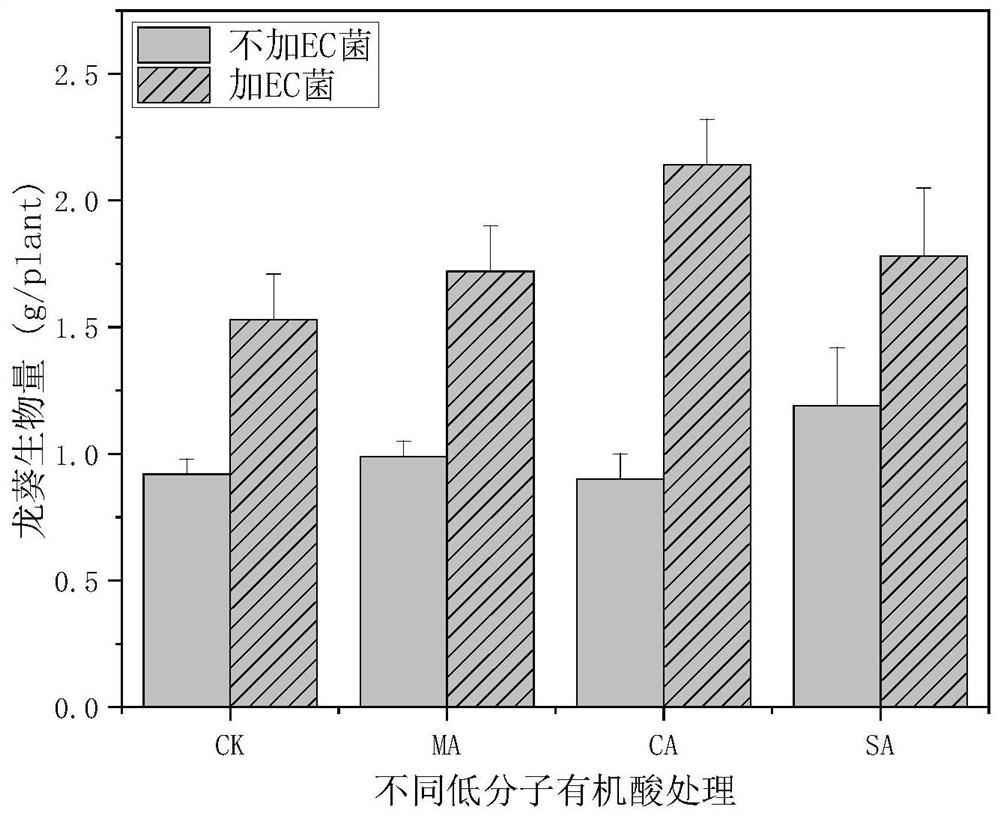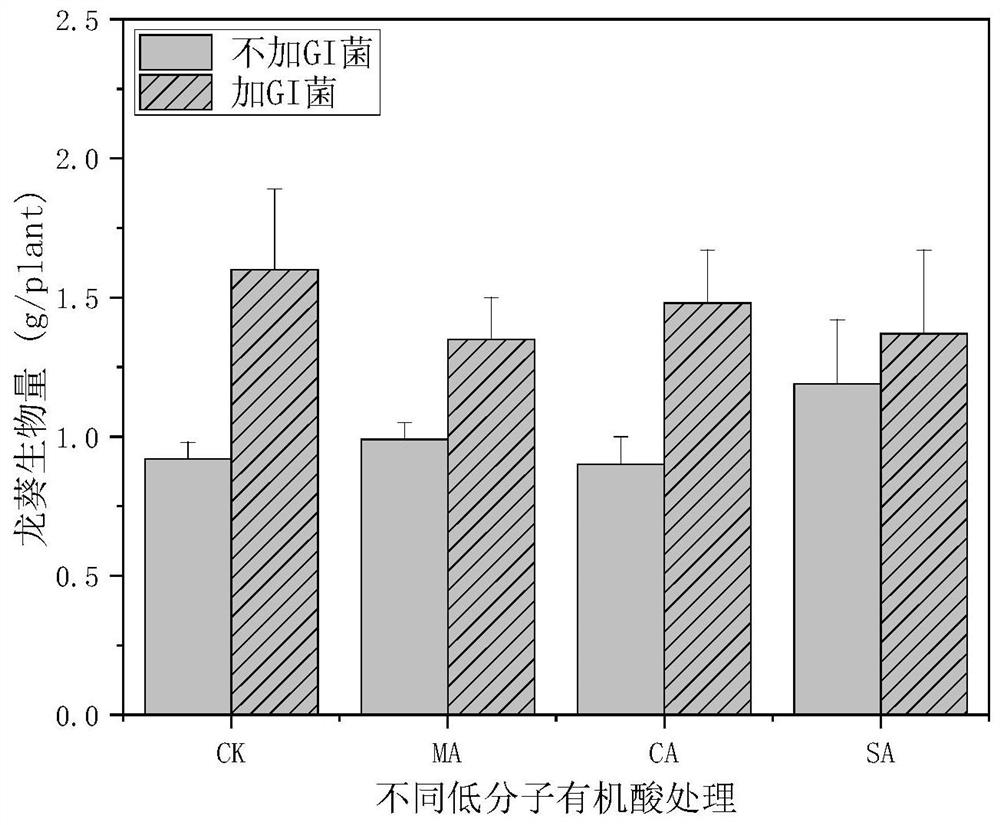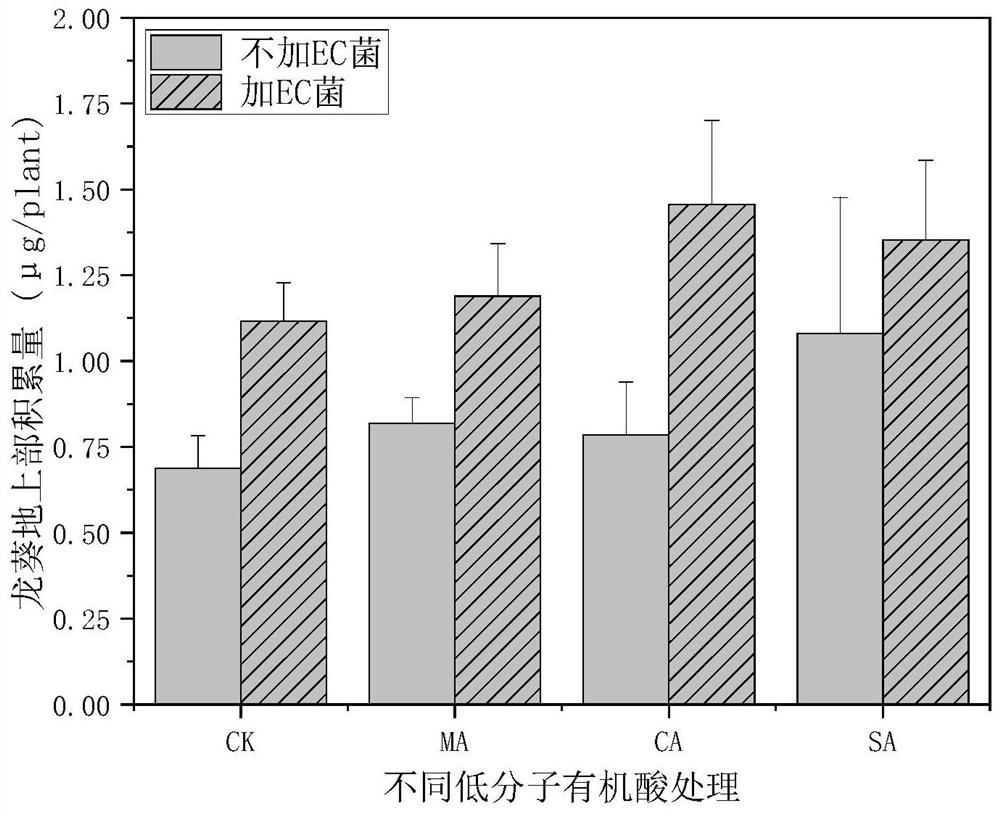Method for enhancing colonization of enterobacter cloacae Y16 in plant root system
A technology of Enterobacter cloacae and plant root system, applied in chemical instruments and methods, fertilizer mixtures, organic fertilizers, etc., can solve the problems of insufficient colonization ability, affecting cadmium absorption of heavy metal hyperaccumulation plants, etc., and achieves increasing biofilm area, The effect of improving repair efficiency
- Summary
- Abstract
- Description
- Claims
- Application Information
AI Technical Summary
Problems solved by technology
Method used
Image
Examples
Embodiment 1
[0031] Embodiment 1 adds low-molecular-weight organic acid to the influence of nightshade nightshade biomass
[0032] The pot design includes siderophore bacteria (EC), Pseudomonas fluorescens (GI), three low-molecular organic acids (MA, CA and SA) and no bacteria (CK), a total of 15 treatments, each treatment 3 in parallel, a total of 45 pots. Adopt the flower pot that diameter is 18cm, every pot is equipped with 1.5kg farmland soil (total cadmium content is 1.087mg / kg, pH value is 7.26, and available phosphorus concentration is 38.54mg / kg), regulates about 80% of water holding capacity in the pot. Preparation of bacterial suspension: inoculate EC and GI bacteria into LB liquid medium from a slant, 28°C, 150r min -1 Cultivate on a shaker for 14h, 4 000r·min -1 Centrifuge for 10 minutes to collect the bacteria, resuspend with an equal volume of sterile water for later use (the concentration of the bacteria solution is 10 8 CFU / mL), and a certain concentration of low-molecul...
Embodiment 2
[0034] Example 2 Effects of Different Small Molecular Organic Acids and EC or GI Bacteria on Solanum Solanum Cd Accumulation
[0035] Harvest the aerial part of Solanum nigrum, place it in an oven for 0.5h at 105°C, and then completely dry it at 60°C. After digestion with concentrated nitric acid, the concentration of heavy metals in the solution was measured, and the accumulation of cadmium in Solanum nigrum was obtained through conversion. Such as image 3 The results showed that, compared with the group inoculated with EC alone, exogenous addition of 50 μmol / L low-molecular organic acid could increase the cadmium accumulation of Solanum solanum, among which the cadmium accumulation of EC+CA and EC+SA increased most significantly, followed by EC+CA (+30.47%)>EC+SA (+21.15%)>EC+MA (+6.54%). However, the cadmium accumulation in the GI group was not increased by the addition of low-molecular organic acids (such as Figure 4 Shown), on the contrary, compared with adding GI bact...
Embodiment 3
[0036] The colonization of embodiment 3EC or GI bacterium in Solanum nigrum root system
[0037] The colonization and distribution of green fluorescent protein-labeled EC bacteria in the root system of Solanum nigrum were observed by laser confocal microscopy. Such as Figure 7 It was shown that, compared with the EC group alone, exogenous addition of 50 μmol / L low-molecular organic acid can promote the formation of stable and sheet-like biofilms of Enterobacter cloacae Y16 in the root system of Solanum nigrum. It was confirmed that specific low-molecular-weight organic acids strengthened the biofilm formation of EC bacteria, thereby enhancing their colonization ability in plant roots.
PUM
 Login to View More
Login to View More Abstract
Description
Claims
Application Information
 Login to View More
Login to View More - R&D
- Intellectual Property
- Life Sciences
- Materials
- Tech Scout
- Unparalleled Data Quality
- Higher Quality Content
- 60% Fewer Hallucinations
Browse by: Latest US Patents, China's latest patents, Technical Efficacy Thesaurus, Application Domain, Technology Topic, Popular Technical Reports.
© 2025 PatSnap. All rights reserved.Legal|Privacy policy|Modern Slavery Act Transparency Statement|Sitemap|About US| Contact US: help@patsnap.com



